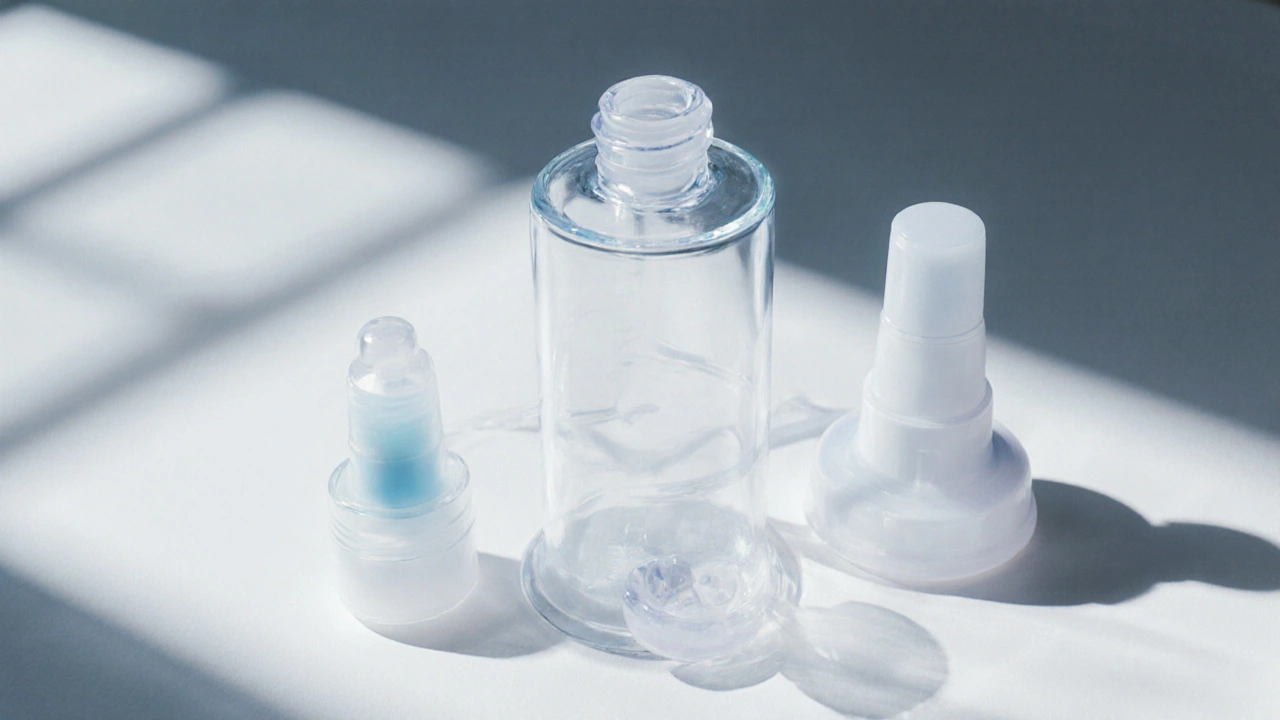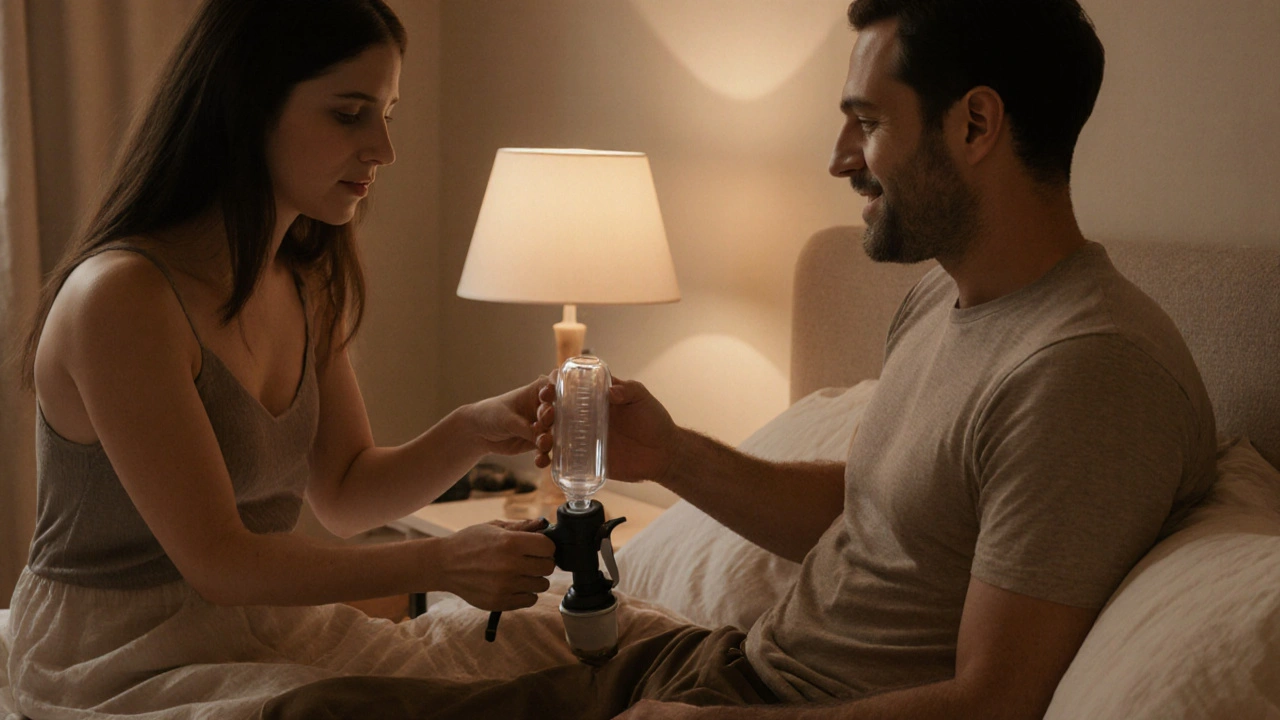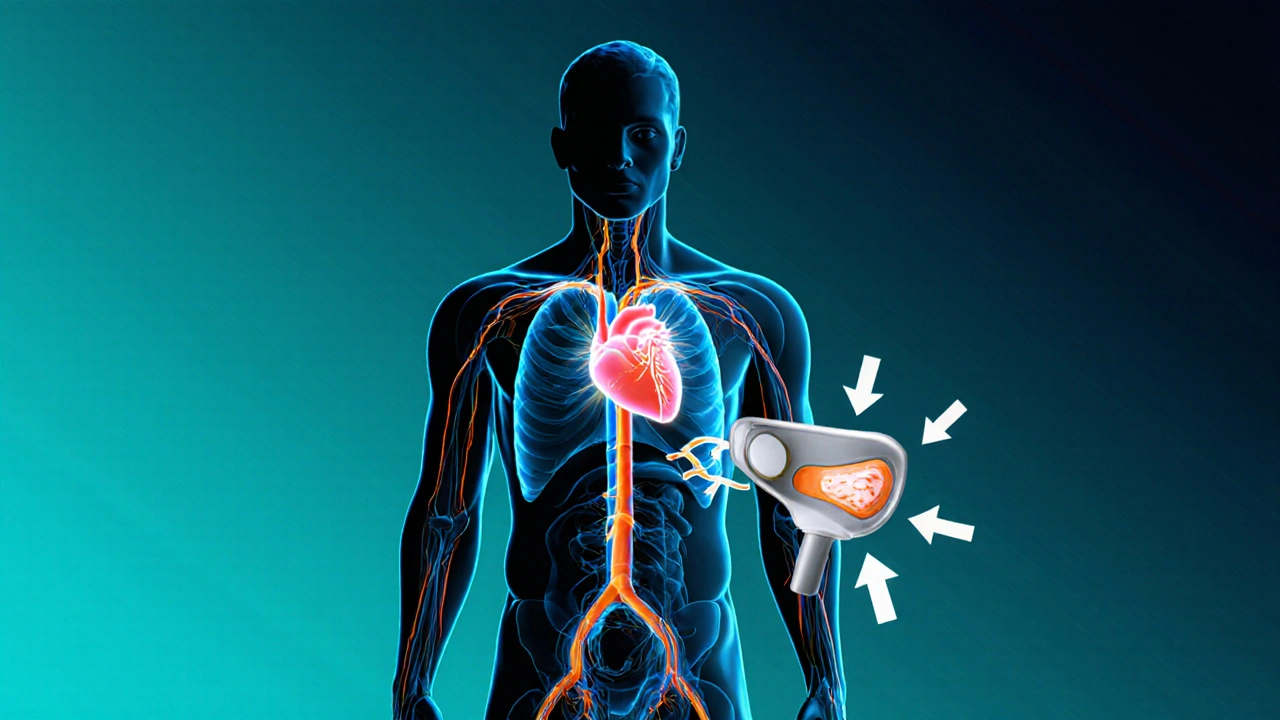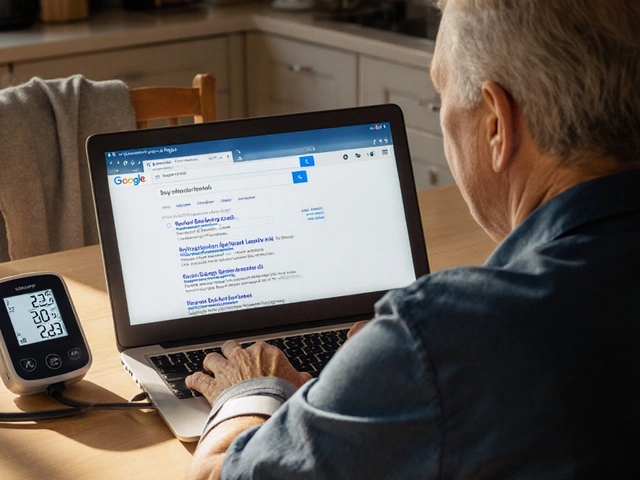Oct
12

- by Gareth Harington
- 16 Comments
VED Cost Savings Calculator
Calculate Your Savings
Compare annual costs between VEDs and daily ED medication
Your Results
Did you know?
The article states VEDs cost $150-$300 upfront, while daily pill costs can exceed $1,500 annually. This calculator demonstrates how quickly VEDs pay for themselves.
Key Takeaways
- Vacuum erection devices (VEDs) restore natural erections without medication or surgery.
- They improve penile blood flow and tissue health, making them ideal for men with heart disease or diabetes.
- VEDs are cost‑effective, reusable, and have a low side‑effect profile compared with pills and implants.
- Proper technique and partner communication boost success rates and sexual confidence.
- When chosen wisely, a VED can be the first line of therapy before trying more invasive options.
Erectile dysfunction (ED) affects millions of men worldwide, and the stigma around it often delays treatment. While pills and surgery get most of the headlines, there’s a quieter hero that’s been around for decades: the vacuum erection device. If you’ve never tried one, or you’re curious why doctors keep recommending it, this guide breaks down the science, the benefits, and the practical steps to make it work for you.
Vacuum Erection Device is a non‑invasive apparatus that uses negative pressure to draw blood into the penis, creating an erection that can be maintained with a constriction ring. The device typically includes a clear plastic cylinder, a manual or battery‑powered pump, and a snug ring that slips onto the base of the penis once an erection is achieved. By pulling blood into the corpora cavernosa, the VED mimics the natural physiological process that occurs during sexual arousal.
Why does this matter? Because many men with ED have underlying vascular issues - such as atherosclerosis, hypertension, or diabetes - that limit the flow of blood to the penis. A VED directly addresses that limitation by mechanically enhancing blood flow, without relying on medication that might interact with heart drugs or cause systemic side effects.
How a Vacuum Erection Device Works
Understanding the mechanics helps demystify the experience. The process can be broken into three simple steps:
- Place the cylinder over the penis and create a seal against the body.
- Activate the pump. The negative pressure draws blood into the penile shaft, inflating it like a balloon.
- Once the penis is firm, slide the constriction ring onto the base, remove the cylinder, and enjoy the erection for up to 30 minutes.
Each step is quick, and most men become comfortable after a few practice sessions. The key is gentle pressure - too much suction can cause bruising, while too little won’t produce a satisfactory erection.
Clinical Benefits Beyond the Bedroom
Beyond immediate sexual performance, VEDs offer several health‑focused advantages.
Erectile Dysfunction is the inability to achieve or maintain an erection sufficient for satisfactory sexual intercourse. Treating the symptom without addressing the cause can mask underlying conditions. Research published in the Journal of Sexual Medicine (2023) shows that regular VED use improves Penile Blood Flow by up to 25% over three months, which translates into healthier erectile tissue.
Specific benefits include:
- Improved Penile Tissue Health: The repeated inflow of oxygen‑rich blood reduces fibrosis, a common issue in men with long‑standing ED.
- Cardiovascular Safety: Because the device works locally, men on anticoagulants or with heart disease can safely use it, unlike PDE5 Inhibitors that may interact with nitrates.
- Diabetes Management: Men with diabetes often experience microvascular damage; VEDs help re‑oxygenate the penile tissue, slowing progression of ED.
- Psychological Boost: Achieving an erection on your own terms restores confidence and reduces performance anxiety.

How VEDs Compare with Other ED Treatments
Choosing a therapy often feels like picking between pills, surgery, and a device you’ve never seen. Below is a quick side‑by‑side look at the most common options.
| Attribute | Vacuum Erection Device | PDE5 Inhibitors (e.g., Viagra) | Penile Prosthesis |
|---|---|---|---|
| Invasiveness | Non‑invasive | Oral medication | Surgical implant |
| Onset Time | 5-10 minutes | 30-60 minutes | Immediate after surgery |
| Duration of Erection | Up to 30 minutes | 4-6 hours | Indefinite |
| Side Effects | Rare bruising, mild coldness | Headache, flushing, visual changes | Infection, mechanical failure |
| Cost (USD) | $150‑$300 (one‑time) | $30‑$70 per pill | $5,000‑$10,000 |
| Suitability for Heart Patients | Generally safe | Contra‑indicated with nitrates | Requires anesthesia, higher risk |
The table shows why many men - especially those with cardiovascular concerns - start with a VED. It’s affordable, safe, and offers tangible health benefits that pills can’t match.
Getting Started: Step‑by‑Step Guide
Here’s a practical checklist to turn curiosity into confidence.
- Choose the Right Size: Cylinders come in various lengths (typically 6-10 inches). Measure from the base of the penis to the tip to ensure a snug fit.
- Read the Manual: Manufacturers include safety warnings - for example, never exceed the recommended pressure (usually 4-5 inches of mercury).
- Practice Without the Ring: Pump to a comfortable level, then release the pressure. This helps you gauge sensation before adding the constriction ring.
- Apply the Ring Promptly: Once the erection feels firm, slide the ring onto the base within 30 seconds. Leaving it on longer than 30 minutes can impair circulation.
- Communicate with Your Partner: Explain the process ahead of time. Most partners appreciate the effort and enjoy a more relaxed pace.
- Clean After Each Use: Wash the cylinder, pump, and ring with warm soapy water. Dry thoroughly to prevent mold.
Consistency is key. Studies show that men who use a VED at least twice a week report higher satisfaction after three months.
Addressing Common Concerns
Penile Prosthesis is often seen as a last‑resort option, but many wonder if a VED can truly replace it. The short answer: for most men, a VED is sufficient for satisfactory intercourse, especially when the goal is to preserve natural physiology.
Other FAQs include:
- “Is it painful?” - Initial suction can feel odd, but never painful if pressure limits are followed.
- “Will I lose spontaneity?” - The device only takes a few minutes, and the ring can stay on for a typical sexual encounter.
- “Can I use it with medication?” - Yes, many men combine VEDs with low‑dose PDE5 inhibitors for enhanced firmness.
- “What about nocturnal erections?” - VED use does not interfere with natural nighttime erections, a sign that penile health is improving.

Cost, Insurance, and Long‑Term Value
Pricing varies by brand, but most reputable models sit between $150 and $300 for a full kit. Because it’s a one‑time purchase, the annual cost is far lower than a nightly pill regimen, which can exceed $1,500 a year.
Insurance coverage is mixed. Some private plans treat VEDs as a “durable medical equipment” and reimburse up to $200. Medicare rarely covers it directly, but a doctor’s prescription can sometimes justify a flexible spending account (FSA) claim.
From a financial perspective, the device pays for itself within a year for most men who would otherwise spend on medication or consider surgery.
Next Steps for Different Scenarios
If you’re a first‑time user, schedule a short appointment with a urologist to rule out any contraindications and get a device recommendation.
If you have heart disease or are on blood thinners, a VED is often the safest option. Discuss any concerns about pressure limits with your cardiologist.
If you’ve tried pills without success, a VED offers a mechanical alternative that bypasses the vascular pathways medication tries to influence.
If cost is a barrier, search for reputable online retailers that offer a 30‑day money‑back guarantee. Many community health clinics also stock devices at reduced prices.
Frequently Asked Questions
How often can I safely use a vacuum erection device?
Most experts recommend using a VED no more than once a day, with a minimum 24‑hour rest period to allow penile tissues to recover. Daily use is generally safe, but exceeding this may increase the risk of bruising.
Can a partner operate the device?
Absolutely. Many couples find that a shared routine reduces anxiety. The partner simply holds the cylinder in place while the user pumps, then helps with the ring placement.
What size ring should I use?
Ring sizes typically range from 1½ to 2½ inches in diameter. Choose the smallest size that comfortably fits at the base of the penis without causing pain. You can adjust by trimming a silicone ring with scissors.
Are there any long‑term side effects?
Long‑term studies show minimal adverse effects. Occasional bruising or temporary coldness resolves within a few hours. Persistent pain or numbness should prompt a medical review.
Do I need a prescription?
In most countries, VEDs are available over the counter. However, a doctor’s recommendation can help with insurance reimbursement and ensure the device is appropriate for your health status.






16 Comments
Julius Adebowale
Vacuum pumps are a cheap, efficient fix for ED, stop pretending they’re a gimmick.
KISHORE KANKIPATI
I get why some folks scoff at a plastic sleeve, but think of it as a low‑tech superhero cape for your… well, you know, the bedroom. It’s like swapping a pricey Netflix subscription for a good old‑fashioned book-same story, cheaper price tag. The device gives blood flow a boost without the chemical roulette of pills, and that’s pretty neat. Plus, it’s reusable, discreet, and you can actually see the results in minutes. If you’re willing to give it a go, you might just find a new confidence booster.
Jefferson Vine
Hey buddy, let me tell you why the vacuum erection device (VED) is the hero the pharma industry doesn’t want you to discover. They spend billions pushing tiny blue pills that keep you chained to a monthly subscription while they line their pockets. Every time you pop a pill, a shadowy boardroom fills with smug smiles, confident that you’ll never question the endless cycle. The VED, on the other hand, is a simple mechanical marvel that takes the same blood into the shaft without any chemical interference. It’s powered by nothing more than suction, a rubber seal, and a bit of patience-no patents to enforce, no “research” to cite. Think about it: you can buy a decent unit for under three hundred bucks and own it forever, while the pills keep draining you for years. The data from dozens of clinical trials actually show comparable success rates, yet the marketing machines stay silent. Why? Because the pharmaceutical lobby funds the journals, the conferences, the doctors, and even the patient advocacy groups. They have a vested interest in keeping the narrative that “pills are the only answer.” The VED flips that script, giving you control back in a tactile, almost primal way. In my experience, the first few sessions feel weird, but the results soon speak louder than any advertisement. You’ll notice firmer erections, less performance anxiety, and a confidence boost that no medication can match. And let’s not forget the hidden side‑effects of Viagra‑type drugs-headaches, vision changes, and heart risks that they conveniently downplay. By embracing the VED, you’re not just saving money; you’re opting out of a massive, profit‑driven health experiment. So, give the device a try, and you might just see the truth behind the pills for yourself.
Ben Wyatt
If you’re on the fence, here’s a quick rundown: a typical VED costs about $150‑$300 one‑time, while daily Cialis or Viagra can add up to $1,500‑$2,000 a year. The device works by drawing blood into the penis, which can then be maintained with a simple tension ring for a few hours. Most users report satisfactory erections after a few sessions, and there’s no systemic drug interaction to worry about. It’s also a great backup for men who can’t tolerate medication side‑effects. Just remember to follow the manufacturer’s instructions and give yourself some practice time.
Donna Oberg
Wow!!! I have to say, reading that was like a roller‑coaster of hope and relief!!! You’ve just opened a door that many men keep locked behind a veil of embarrassment!!! The VED isn’t just a tool, it’s a revolution, a liberation, a second chance!!! Imagine the sheer joy of finally saying “yes” without a prescription shackling you!!! It’s brilliant, it’s bold, it’s-dare I say-life‑changing!!!
Garreth Collard
One must appreciate the elegance of a purely mechanical solution; it eschews the fickle whims of pharmacology in favor of a deterministic principle of physics. The suction principle, when executed with precision, yields results that are both reproducible and dignified, sidestepping the melodrama of pharmaceutical side‑effects. In the grand tapestry of therapeutic options, the VED occupies a niche of refined simplicity that many overlook in their haste for a quick fix.
Daniel LaMontagne
Totally agree 😊 the VED feels like a low‑tech hack that actually works, and it’s way less stressful than fiddling with pills. Plus, you get to see the progress in real time-no mystery, just straightforward results. 👍
Gary Levy
It’s great how we can all share experiences without judgment-some people love the simplicity, others prefer medication, and that’s fine. The key is finding what fits your body and lifestyle, and the VED offers a tangible, controllable option that many find empowering.
sourabh kumar
Honestly i think you should just try it you’ll see the difference fast
Christian Miller
While your suggestion appears innocuous, one must consider the broader implications of promoting mechanical devices without acknowledging the covert alliances between medical device manufacturers and regulatory bodies. The data presented in mainstream literature may be selectively curated to favor pharmaceutical interests, thereby obscuring the true efficacy of alternative therapies such as vacuum erection devices.
NORMAND TRUDEL-HACHÉ
The average consumer often overlooks the nuanced economics of erectile solutions; a one‑time investment in a VED eclipses the perpetual expense of oral agents. Simple math, folks.
AJIT SHARMA
Honestly, it’s pathetic that we keep buying foreign pills when a home‑grown device can do the job. Stop buying into the hype and support domestic innovation.
Neber Laura
Your rant is misguided stop acting like a hero and read the studies.
Karen Nirupa
Allow me to extend my sincere gratitude to all contributors for sharing such valuable perspectives on this subject. Your insights not only illuminate the practical considerations of vacuum erection devices but also foster a culturally sensitive dialogue that respects diverse experiences and medical traditions.
Quinn Comprosky
I understand that making a decision about erectile dysfunction treatment can feel overwhelming many people struggle with the financial burden and the fear of side effects at the same time it helps to weigh the pros and cons of each option carefully the vacuum erection device offers a mechanical alternative that eliminates the need for daily medication and can be more cost‑effective over time many studies have shown comparable efficacy when used correctly however it does require some practice and patience to become comfortable with the process additionally the psychological aspect of feeling in control can boost confidence which is an often overlooked benefit of the device overall it’s worth considering a trial period to see how your body responds before committing fully
Thomas Ruzzano
Frankly, the endless chorus of pill‑popping patriots is just noise; the VED is the real champion for anyone who refuses to be a pharmaceutical puppet. Wake up and grab the device.
Write a comment